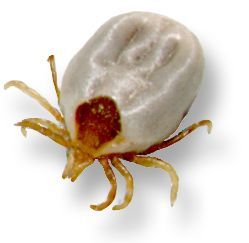The Paralysis Tick of Australia, Ixodes holocyclus
|
TREAT AS FOR CHF- Research at University of Qld suggests treating pulmonary oedema in the same way as for congestive heart failure. See below. TICK NUMBERS ON THE RISE around Sydney- global warming, recent weather patterns, overgrown gardens, composting and mulching may be contributing to a steady increase in tick numbers by enhancing tick survival. Additionally, overgrown public recreational areas with abundant shade and overhanging branches are where pets and people are increasingly likely to pick up the ticks. (Bill Conroy, Aug 2000). Significant larval tick infestations reported in Sydneys northern suburbs - March 2003 (TAGS tick report, Jan 2003). |

|
ALERT- Rickettsia australis, the bacterium responsible for Australian Rickettsial Spotted Fever (="Queensland Tick Typhus") in humans, appears to be very prevalent amongst the tick population of the Pittwater area, just north of Sydney. See also Tick Alert Group Support (TAGS). DON'T
DELAY- even if you merely suspect signs of tick
poisoning on your pet, please contact your local veterinarian early!
Don't "wait and see". |
introduction |
IXODES HOLOCYCLUS |
|
The aim of this site is to act as a source of information and links concerning recent developments in the prevention and treatment of tick poisoning as caused by Ixodes holocyclus. General information on the biology of the paralysis tick will hopefully also be of interest. The focus is on domestic animals, particularly dogs and cats which seem to be particularly sensitive, but I will also endeavour to collate information pertaining to native animals and humans. Most of the information comes from reputable published sources which have been referenced. I have inserted personal comments, based on direct observations, in square brackets where appropriate. Please Note. The information presented here is not intended to substitute for professional veterinary, medical or acarological advice. |
| TICK RELATED LINKS |
|
There are a number of links within specific topics, but the following are some general ones:
|
| VETERINARY LINKS |
|
| LOCAL ILLAWARRA LINKS |
|
|
| footnotes |
|
E-mail Us to report a broken link!